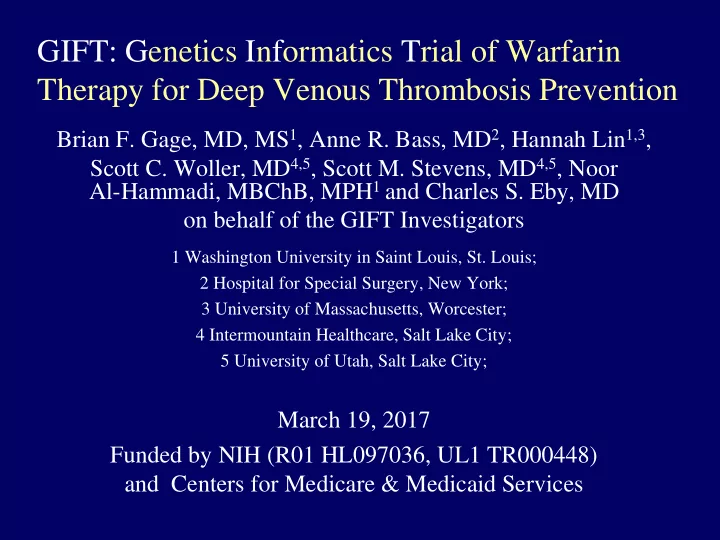

GIFT: Genetics Informatics Trial of Warfarin Therapy for Deep Venous Thrombosis Prevention Brian F. Gage, MD, MS 1 , Anne R. Bass, MD 2 , Hannah Lin 1,3 , Scott C. Woller, MD 4,5 , Scott M. Stevens, MD 4,5 , Noor Al-Hammadi, MBChB, MPH 1 and Charles S. Eby, MD on behalf of the GIFT Investigators 1 Washington University in Saint Louis, St. Louis; 2 Hospital for Special Surgery, New York; 3 University of Massachusetts, Worcester; 4 Intermountain Healthcare, Salt Lake City; 5 University of Utah, Salt Lake City; March 19, 2017 Funded by NIH (R01 HL097036, UL1 TR000448) and Centers for Medicare & Medicaid Services
The Problem: Warfarin works, but Warfarin causes more emergency department visits among the elderly than any other drug (N. Shehab JAMA 2016). INR = International Normalized Ratio. Values > 3 or 4 predispose to bleeding.
Genetics Informatics Trial (GIFT) of Warfarin Therapy for DVT Prevention • Hypothesis: Pharmacogenetic dosing of warfarin therapy decreases the rate of adverse events vs. clinical-algorithm dosing 3
Warfarin CYP1A1 CYP1A2 CYP2C9 CYP3A4 VKORC1 CYP4F2 Oxidized Vitamin K Reduced Vitamin K K 1 - OH CO 2 O 2 GGCX Functional Hypofunctional F. II, VII, IX, X F. II, VII, IX, X CALU Gage B & Eby C. Pharmacogenomics J. 2004
Warfarin Pharmacogenetics • Cytochrome P450 2C9 ( CYP2C9) SNPs slow S- warfarin metabolism • VKORC1-1639 G>A Vitamin K epoxide reductase increases warfarin sensitivity • CYP4F2 V433M reduces vitamin K clearance
2 x 2 Factorial Design
Genotyping Strategy • Initially: Genotyping at clinical sites with retrospective confirmation and DNA banking by Central Laboratory • Later: Central laboratory provided pre- surgery genotyping for all clinical sites • Genotype Method: Predominantly GenMarkDx eSensor instrument and reagents 7
Randomization & Double Blinding • Randomized 1:1 to genetic vs. clinical dosing – stratified by arthroplasty site, self-identified race, and center: HSS, Intermountain Healthcare, Rush, University of Utah, UT Southwestern, and WUSTL • Participants and study personnel were blind to study arm and genotype, but not to warfarin dose 8
Primary Outcome Was a Composite of: • Major bleeding within 30 days, • INR ≥ 4 within 30 days, • Death within 30 days, and • Venous thromboembolism (VTE) confirmed by objective testing within 60 days of arthroplasty – Patients were screened for DVT using Duplex US 9
Statistical Analyses • Modified intention-to-treat basis – included all randomized participants who received 1+ doses of warfarin. • A priori high-risk subgroup: – Participants whose clinical and genetic predicted doses (on day 1) differed by > 1.0 mg/day. • Two-sided alpha of 0.05, partitioned: – 0.044 alpha required in total cohort – Remaining alpha in high-risk subgroup • 1600 participants provided 80% power 10
GIFT CONSORT Diagram
GIFT Participants Genetic Clinical Variable N=808 N=789 Age, years: mean (SD) 72.2 (5.3) 72.0 (5.5) Indication: N (%) Hip Replacement 207 (25.6) 199 (25.2) Knee Replacement 601 (74.4) 590 (74.8) Female: N (%) 522 (64.6) 496 (62.9) Race: N (%) African American 52 (6.4) 50 (6.3) American Indians or Native 1 (0.1) 0 (0.0) Asian or Indian Subcontinent 16 (2.0) 13 (1.7) Caucasian 735 (91.0) 719 (91.1) Statin†: N (%) 365 (45.2) 402 (51.0) Diabetes: N (%) 116 (14.4) 105 (13.3) † P = 0.02.
From Days 1-11, WarfarinDosing.org Provided Guidance; Clinicians Did the Dosing
From Days 1-11, WarfarinDosing.org Provided Guidance; Clinicians Did the Dosing
Primary Results (N = 1597) Genotype Group, Clinical Group, Endpoint N = 789, % (N) P-value N = 808, % (N) Major bleed (days 1-30) 0.25% (2) 1.01% (8) 0.062 INR ≥ 4 (days 1 -30) 6.9% (56) 9.8% (77) 0.041 VTE (days 1-60) 4.1% (33) 4.8% (38) 0.48 Death (days 1-30) 0.0% (0) 0.0% (0) 1.00 Total 10.8% (87) 14.7% (116) 0.018 Genetic dosing reduced the relative risk of adverse outcomes by 27% (RR=0.73; 95% CI: 0.56 – 0.95).
Benefit of Genetic Dosing Was Consistent: • There was no significant interaction in any of these subgroups – African-Americans – CYP2C9 genotype – Target INR 2.5 vs. 1.8 – Hip vs. knee arthroplasty 16
Secondary Outcome: Percentage of Time in the Therapeutic Range (PTTR) During Days 4-28 of Warfarin Therapy Analyses Genotype-Group Clinical Group Mean Difference N PTTR N PTTR (95% CI) P Value Overall 803 54.7 785 51.3 3.4 (1.1, 5.8) 0.004 321 55.5 333 48.4 High-risk 7.0 (3.4, 10.6) 0.0002 Stratified by Target INR Target 2.5 (2.0-3.0) 399 56.2 389 50.4 5.8 (2.5, 9.1) 0.0006 Target 1.8 (1.5-2.1) 404 53.3 396 52.1 1.1 (-2.2, 4.5) 0.51
GIFT Conclusions • Algorithm-assisted warfarin dosing is safe – Dosing algorithms from WarfarinDosing.org should be integrated into EMRs • Genotype-guided dosing reduced the relative risk of adverse outcomes by 27% – Improved INR control, especially among high-risk subgroup. Funded by NIH (R01 HL097036, UL1 TR000448) and Centers for Medicare & Medicaid Services 18
Recommend
More recommend